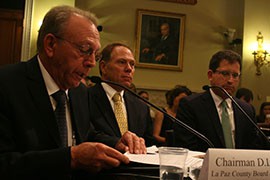- Slug: BC-CNS-Renewable Land,590
- Sidebar: How royalties would be used
- Photos available (thumbnails, captions below)
By MATTHEW SEEMAN
Cronkite News Service
WASHINGTON – Arizona could become the “solar capital of the world” if public lands can be made more readily available for renewable energy development, an Arizona official told a House subcommittee Tuesday.
Eric Fitzer was one of two Arizonans – along with La Paz County Board of Supervisors Chairman D.L. Wilson – testifying in support of a bill that calls for pilot programs to lease federal land for renewable energy development. Royalties from subsequent energy sales would be split between state, local and federal governments and conservation efforts.
Fitzer, senior energy programs manager for the Governor’s Office on Energy Policy, told a House Natural Resources subcommittee that Arizona has grown its renewable portfolio in the last few years, but access to federal land would help it make great strides toward developing solar energy. The federal government owns 42 percent of the state’s nearly 73 million acres, Fitzer said – land the state needs to reach its full renewable-energy potential.
“For Arizona to become the solar capital of the world, Arizona will look to development of public lands in order to achieve this goal,” Fitzer said.
The bill‘s sponsor, Rep. Paul Gosar, R-Prescott, said in opening remarks that public land provides tremendous potential for producing renewable energy and reducing dependence on foreign energy. He said his bill would streamline the permitting process and shorten wait times, encouraging more development.
“Uncertainty in the permitting process impedes or delays our ability to harness our renewable energy potential, and it must be reformed,” Gosar said.
Another benefit to increased renewable energy production would be increased royalties, which can be used by local governments for roads, law enforcement and other services, Wilson said. While he was testifying on behalf of the National Association of Counties, Wilson said any extra royalty money in La Paz County would likely go toward road repair.
“This revenue sharing will … provide the county with the much-needed resources to provide the infrastructure and services that our citizens depend upon,” he said.
But the royalties and the competitive leasing of federal land worried Arthur Haubenstock, chairman of the Solar Energy Industries Association’s utility-scale solar power division. He testified that large-scale solar is not mature enough for competitive bidding and payment of royalties, which could lead to a disincentive to innovate instead of the industry growth supporters envision.
“There’s a question of risk, and there’s a question of how will these factors work together,” Haubenstock said.
The Bureau of Land Management is concerned, on the other hand, that lease and royalty payments may not be enough for “an appropriate return to U.S. taxpayers” on the land, said Michael Nedd, an assistant director for energy, minerals and realty management. Nedd said the bureau shares the goals of the bill, but wants to work with lawmakers to ensure it’s both efficient and safe.
In addition to feeding government coffers, the bill calls for 25 percent of any proceeds from renewable energy development projects to be set aside in a conservation fund to help offset any damage a project causes to the land. That provision drew the support of Trout Unlimited.
“This conservation fund is essential to our ability to balance wind and solar energy development with the kind of unparalleled hunting and fishing opportunities that make our western public lands a prime destination,” said Chris Wood, president and CEO of Trout Unlimited.
Ultimately, Gosar said, the bill is an example of various levels of government collaborating to solve mutual problems, helping local communities affected in the process.
“I want my cake, and I want to eat it too,” he said.
^__=
Web Links:
_ HR 596 (Public Lands Renewable Energy Development Act): https://beta.congress.gov/113/bills/hr596/BILLS-113hr596ih.pdf
_ Wilson’s testimony: http://naturalresources.house.gov/uploadedfiles/wilsontestimony7-29-14.pdf
_ Fitzer’s testimony: http://naturalresources.house.gov/uploadedfiles/fitzertestimony7-29-14.pdf
_ Nedd’s testimony: http://naturalresources.house.gov/uploadedfiles/neddtestimony7_29_14.pdf
_ Haubenstock’s testimony: http://naturalresources.house.gov/uploadedfiles/haubenstocktestimony7-29-14.pdf
^__=
SIDEBAR:
Renewable revenue
A bill to boost the development of renewable energy projects on public lands could also boost lease and royalty payments from those lands, supporters say. The bill calls for fevenues from renewable-energy projects to be split between:
– 25 percent to states where the revenue is created.
– 25 percent to counties where the revenue is created.
– 25 percent to a renewable-energy resource conservation fund.
– 15 percent to Bureau of Land Management state offices and Forest Service regional offices in states where the revenue is created (for the first 15 years the bill is law).
– the remainder to the Treasury Department’s general fund.
^__=
Eric Fitzer, center, of the Governor’s Office of Energy Policy, told a House committee that a bill that would open public land to renewable energy development could make Arizona the “solar capital of the world” if the state could take advantage of available land. (Cronkite News Service photo by Matthew Seeman)
La Paz County Board of Supervisors Chairman D.J. Wilson testifies in support of a bill that aims to open public land to renewable-energy development, saying such development would help generate revenue the county could use to repair roads and infrastructure. (Cronkite News Service photo by Matthew Seeman)

